The Morecambe trip, like the recent trips to Blackpool and Llandudno, was intended to observe changes since my previous visit to Morecambe and Heysham on 14th December 2013. The visit in 2013 produced two posts - Return to Heysham and, with historical background on the railways, Railways around Morecambe.
Getting there
Once I'd decided that, despite not-very-good weather forecasts, I'd make the trip, I worked out the train times and booked tickets on the internet. I'd use Virgin's 'Pedolino' service from London to Glasgow via Birmingham to Lancaster and, knowing that these trains can get busy, decided to pay the 'Weekend First' surcharge. I also downloaded an electronic ticket to my mobile phone, to avoid either queuing at the ticket office or picking up a paper ticket from a machine at Wolverhampton station. It still seems strange to me to download a ticket to a mobile 'phone - I was brought up in the era of Ericcson pasteboard tickets. The ticket included the leg from Lancaster to Morecambe via Northern. These were the timings:-
| Wolverhapton-Morecambe | Arrive | Depart |
| Wolverhampton | 09:37 | |
| Lancaster | 11:07 | 11:28 |
| Morecambe | 11:37 |
| Morecambe-Wolverhapton | Arrive | Depart |
| Morecambe | 15:09 | |
| Lancaster | 15:18 | 15:38 |
| Preston | 15:56 | 16:17 |
| Wolverhampton | 17:33 |
I also confirmed that it was possible to go from Morecambe to Heysham and back by train but the only service that day allowed just three minutes in Heysham!
| Morecambe-Heysham and return | Arrive | Depart |
| Morecambe | 13:02 | |
| Heysham Port | 13:17 | 13:20 |
| Morecambe | 13:35 |
I arrived at Wolverhampton in plenty of time for my first train, with time to look at the forlorn bulk of Wolverhampton Power Signal Box, still sitting on the up side at the Birmingham end of the station and remember visits I'd made there when it was in use.

Former Wolverhampton Power Signal Box.
As forecast, the skies were rather overcast but it was not cold. My train arrived at Wolverhampton a few minutes late, I found my reserved seat without difficulty and we sped north. At Crewe, we stopped in platform 11 and I was able to take a picture of the large 3-storey office block on the former island platform 1/2. The overall roof which originally covered this platform has gone but modern umbrella roofing has been erected over the former platform 2, now renumbered 12 and seeing occasional use.

Crewe: Station buildings on former platforms 1/2 (trip to Morecambe)
We were soon on our way again, passing all the familiar landmarks, dashing past Weaver Junction where the Liverpool line diverged, glimpsing the Manchester Ship Canal before dashing down the bank to our station stop at Warrington, with the huge soap works on our left. Our route continued north through Winwick Junction, where the branch to the original Liverpool and Manchester Line at Earlestown curves to the left, past the site of the famous Vulcan locomotive works. One of the refurbished Class 319 Electric Multiple Units (cascaded from the London area) was waiting at the signal on the Up Earlestown for us to pass before continuing towards Warrington. Through the magic of Railcam.UK, I was able to follow this on a live signalling diagram on my mobile 'phone (there's a post about Railcam.UK here).
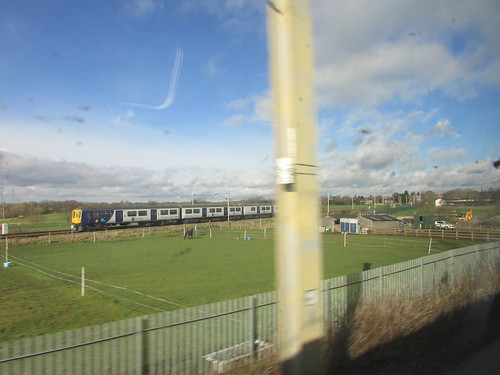
View from my train, 9S47, passing waiting EMU, 2F28, on Earlestown line at Winwick Jn., Warrington (trip to Morecambe)
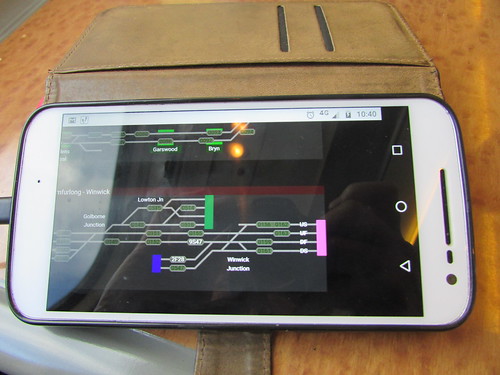
Live signalling diagram of Winwick Jn., Warrington showing my train, 9S47, passing waiting EMU, 2F28, on Earlestown line (trip to Morecambe)
Click here for larger versions of this image
Our route entered a sandstone cutting, passed under the Liverpool and Manchester line then, after Golborne Junction with its branch to the Liverpool and Manchester line, became quadruple track. At Bamfurlong Junction a pair of goods lines peeled left, descended so as to pass under our route and re-appeared on our right at Springs Branch, where the line from Liverpool and Huyton joined on the left.
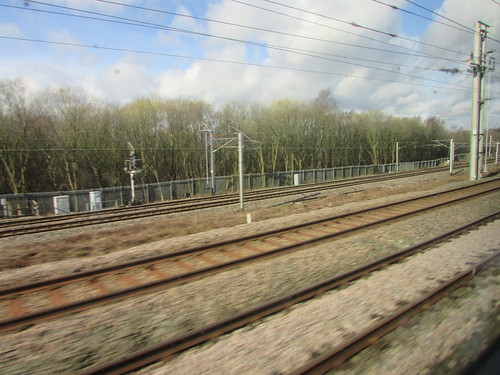
Bamfurlong Jn., Wigan showing Goods Lines descending before crossing under Main Lines (Trip to Morecambe)
Just before our stop at Wigan North Western station, the former Lancashire and Yorkshire line from Manchester appeared on our right, allowing interconnection with our route, before descending to Wigan's other station, Wigan Wallgate, at a lower level. After our brief stop, we passed over the line from Wigan Wallgate, with views of the junction with the line to Kirkby on the left and the line to Southport on the right.
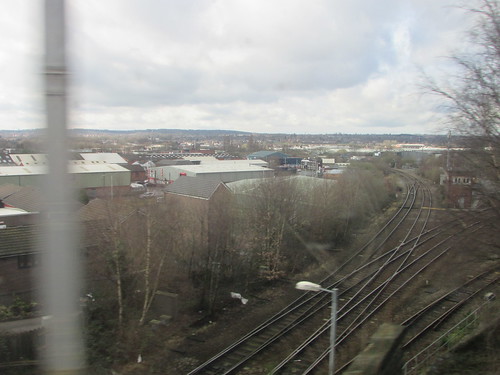
Wigan: View of L&Y lines at low level as we depart from Wigan North Western for Preston (Trip to Morecambe)
The junctions at Boar's Head and Standish are long gone. Quadruple track, paired by use, now resumes before Balshaw Lane and Euxton station with platforms only on the Slow lines on our left. Euxton Junction remains, where the line from Bolton via Chorley joins on our right, but with a much simpler track layout than I remember from steam days. Leyland station followed. Leyland lent its name to a series of motor manufacturing companies established next to the railway. The rather complicated history is briefly outlined in the Wikipedia article here. I certainly remember the British Leyland Motor Corporation and the later years of the saga. I made a few visits to the plant for Ford Electronics when we were helping a client to resolve some problems on the Italian-manufactured automated High Bay Warehouse at the site. More junctions follow at Farington, where a line diverges right to join the former Lancashire and Yorkshire route to Blackburn and at Farington Curve Junction where the 'Lanky' route, having passed over the West Coast Main Line, converges with the Slow lines on our left. The single line from Ormskirk also converges at this location. A few hundred yards further on, the B5254 road crosses over the railway on the skew, giving rise to the railway name Skew Bridge Junction where the Slow lines spawn an additional pair of Goods lines which still extend to the north end of Preston station.
As we left Preston after our stop, I took the picture below showing the Blackpool Line which I'd travelled on 9th February 2019 as described in the post here.
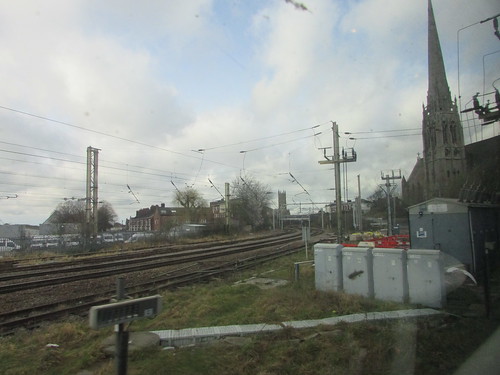
Preston: Fylde Line and St. Walburge's Church, viewed from the WCML. (Trip to Morecambe)
Just 13 minutes are allowed for the Preston to Lancaster 'leg', so I was soon on platform 3 at Lancaster watching my train continue north around the sweeping reverse curve at the north end of the station.

Lancaster station looking north (Trip to Morecambe)
Within ten minutes, a Class 150 Diesel Multiple Unit forming the Morecambe shuttle service appeared on the Up Main and crossed to Bay platform 2. The Driver and lady Guard changed ends, the waiting passengers boarded and we departed for Morecambe right time.

Lancaster station with DMU from Morecambe arriving (Trip to Morecambe)
Shortly after leaving Lancaster, we crossed the broad River Lune. I was seated on the left (as I usually prefer, to give a better chance of observing signals on the journey) so my picture below is looking towards the sea, with the power stations at Heysham visible on the skyline.

Crossing the River Lune having left Lancaster for Morecambe (Trip to Morecambe)
We left the West Coast Main Line at Morecambe South Junction on the reversible single line to Bare Lane Junction, where a similar reversible single line from Hest Bank Junction converged, forming a triangle with the West Coast Main Line. The single line immediately splits into two parallel single lines through Bare Lane station to Morecambe. On my trip in 2013, Bare Lane signal box structure adjacent to the level crossing was still there (although control had already transferred to Preston Power Signal Box) but in 2019, it had gone. The level crossing (the road is called Bare Lane) still had the skirted full lifting barriers and flashing lights I remembered from 2013. This time, I noticed the extra set of flashing lights pointing sideways to face South Road which joins Bare Lane just south of the crossing.

Bare Lane Level Crossing: An extra set of flashing lights face the blue car emerging from South Road (Trip to Morecambe)
It was overcast but dry and pleasantly warm on our arrival in Morecambe so I purchase a return ticket for the later Heysham service before setting off to the seafront down Northumberland Street. I decided to explore along the Stone Jetty. On the Railway Clearing House map of 1913 showing the Morecambe area repeated below, the Stone Jetty is shown as 'Harbour Goods'.

Click here for enlarged view
Details of the lines around Morecambe in 1913 originally published by the Railway Clearing House. Reprinted in 'Pre-Grouping Railway Junction Diagrams 1914', published by Ian Allen (ISBN 0 7110 1256 3).
Of course, there's no sign now of the original tracks but a stone building and lighthouse erected in 1853 survives with a plaque commemorating the earlier use of the Stone Jetty as a railway terminus serving Irish and Scottish Ferries.
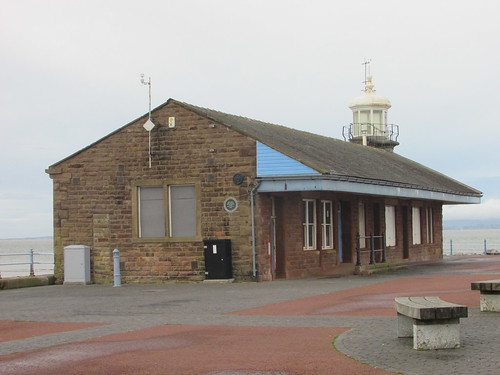
Morecambe: Stone Jetty Terminal Building and Lighthouse.
The Stone Jetty is an excellent vantage point for taking in the sweep of Morecambe Bay and offers good views of the sea-facing elevation of the famous Midland Hotel. The Wikipedia article here describes the architectural style as 'streamline moderne' and provides a useful history.

Morecambe, view looking north from Stone Jetty (Trip to Morecambe)
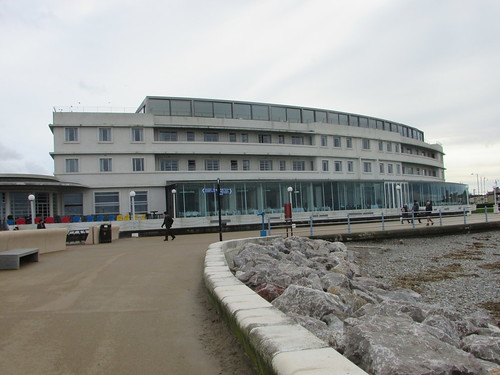
Midland Hotel, Morecambe showing elevation facing the sea (Trip to Morecambe)
The hotel is just yards away from the former Morecambe Promenade station, built by the Midland Railway, now 're-purposed' as Information Centre, Events Venue and Public House.

Morecambe: Former Midland Railway Promenade Station.
I made my way back to the station in plenty of time to catch the Heysham train and was amused to find the electronic Passenger Information Displays had failed.
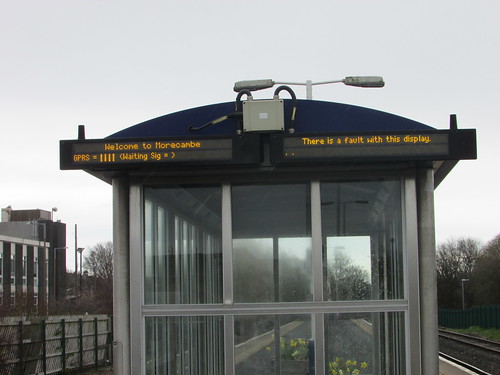
Heysham by rail: Failed Passenger Information Display at Morecambe station.
But the same Class 150 which had brought me to Morecambe, with the same crew, trundled into the station on time.
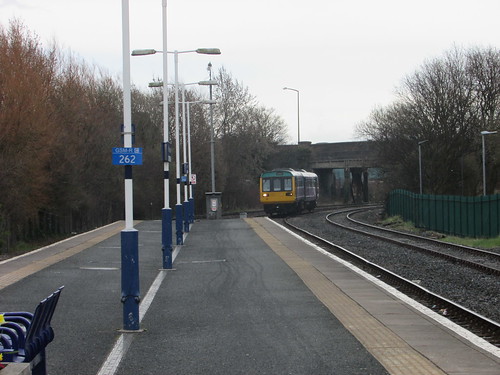
Heysham by rail: The Class 150 shuttle arrives from Lancaster, prior to its trip to Heysham.
Once the crew had changed ends and the three or four passengers had boarded, we set off, stopping at Morecambe Junction ground frame just outside the station. The driver climbed down, contacted Preston Power Box on the telephone, obtained the release, and operated the points mechanically to give access to the Heysham branch. What looked like 2-aspect colour light signals on each approach to the points were Point Indicators which appeared to display steady yellow when the points were 'proved' and flash otherwise but I couldn't confirm this.
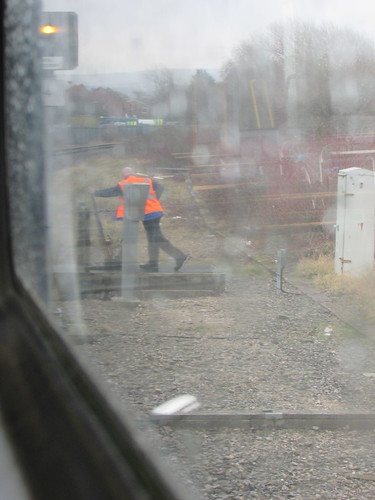
Heysham by rail: The Driver setting the points for the Heysham branch.
Whilst the lines from Bare Lane to Morecambe use Flat Bottom rail continuously welded, the branch to Heysham remains jointed Bullhead rail, so we made an undulating progress with the 4-wheeled vehicles 'nodding' at each fishplate joint and it took all of the 15 minutes allowed to reach Heysham. There was no large ferry docked alongside the station on this trip so my attention turned to the two AGR ('advanced gas-cooled reactor') nuclear power stations operated by EDF Energy (owned by the French state-owned organisation Électricité de France). They looked increasingly careworn cosmetically so that I wondered at first if they'd entered the decommissioning phase. After my trip, the internet confirmed they're both still operational.
Heysham 1 generating 1155 MW is expected to generate until 2024 and there's more here.
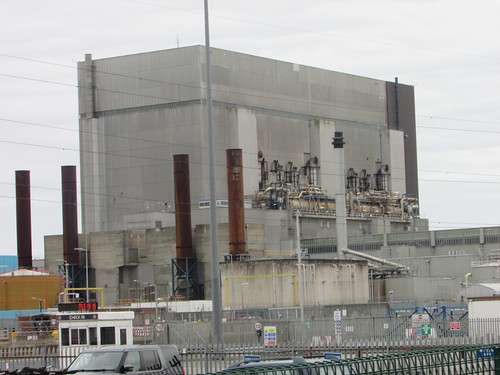
Heysham No. 1 Nuclear Power Station (Heysham by rail).
Heysham 2 generating 1230MW is expected to generate until 2030 and there's more here

Heysham No. 2 Nuclear Power Station (Heysham by rail).
Later, I realised that the nuclear power stations are built on reclaimed land. The 1913 Railway Clearing House Map (above) shows Heysham station built on a jetty thrust into the sea but protected by two long moles to north and south. It would appear that all of the area between the southern mole and the original jetty has been reclaimed and is now home to two nuclear power stations whilst part of the area between the northern mole and the jetty has been reclaimed, leaving a rectangular dock.
As the crew changed ends again, I commented to the friendly driver that he was kept pretty busy with changing and and even having to work the Ground Frame at Morecambe Junction. "Oh, they don't like us standing around!" he replied cheerfully, letting me take a picture of his 'Office'.

Cab of Class 150 at Heysham (Heysham by rail).
After our very brief visit to Heysham, we returned to Morecambe. One reason the Heysham branch remains open is to allow nuclear flask trains to access the power stations and we passed Heysham Power Station Ground Frame shortly after leaving Heysham station.

Siding to Power Stations at Heysham (Heysham by rail).
The fairly exposed area near the power stations had a number of large wind turbines, a large solar installation and what looks like a newer high voltage switchyard in addition to the one I'd seen during the 2013 trip.
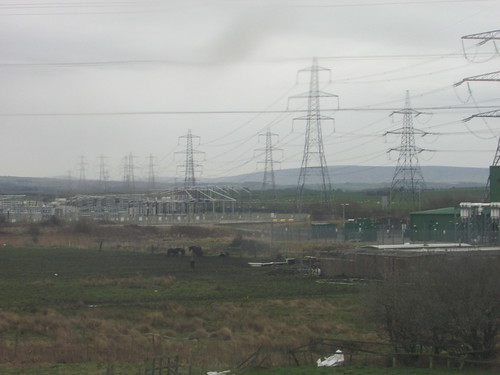
High Voltage Electricity Switchyard and Transmission Lines at Heysham (Heysham by rail).
Back at Morecambe Junction, we joined the two single lines from Bare Lane which originally formed the double-track route into the long-gone Euston Road terminus.
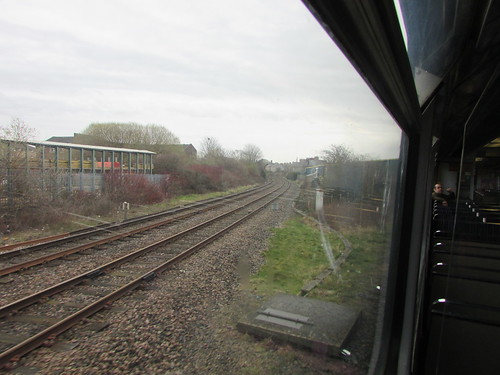
Two single lines from Bare Lane viewed from Heysham branch. Note cable route using pre-cast concrete troughing and concrete 'lid' on cable turning chamber (Heysham by rail).
Having cleared the points to the Heysham branch, we stopped and the driver climbed down and restored the route ready for his next trip back to Lancaster before continuing into platform 2 at Morecambe station.
It was now raining intermittently but I had around an hour and a half before I needed to catch the train back to Lancaster and had determined that I'd spend the time in an excellent second-hand bookshop called The Old Pier Bookshop (you can find their Facebook page here). One of my weaknesses is second-hand books so, by the time I left, I was loaded down with plastic carrier bags of railway titles. There was little time to admire the scenery around Morecambe Bay before I turned inland and hurried back towards the station.
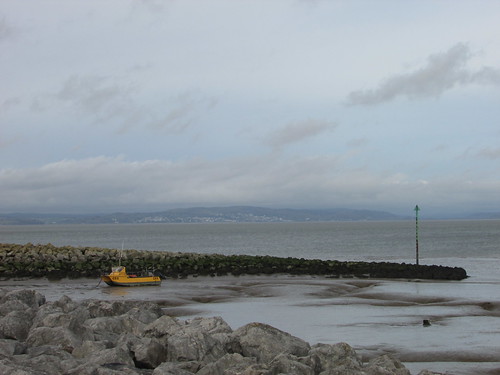
Morecambe: View from Promenade (Trip to Morecambe).
There was a train already waiting in platform 1 but this turned out to be the 15:04 Northern service to Leeds which, on a Saturday, apparently takes the left route at Bare Lane to reach Carnforth without performing a reversal at Lancaster as some trains do. This train departed and the Class 150 I was becoming used to arrived in platform 2. The familiar crew changed ends and we set off back to Lancaster where there was quite a crowd waiting for the 'Pendolino' which would take me as far as Preston.

Lancaster Station showing Up Side station buildings. The Class 150 I'd taken from Morecambe prepares to return to Morecambe (Heysham by rail).
I was starting to tire by the time we arrived at Preston and we were starting to lose the light, discouraging more photography so I was content to board my connecting 'Pendolino' and relax on the familiar route back to Wolverhapton after an interesting day.
Related Posts on this Website
This was my first post on the Morecambe area:-
Steam around Morecambe These posts were written after my 2013 visit:-
Return to Heysham
Railways around Morecambe
My pictures
Where necessary, clicking on an image above will display an 'uncropped' view or, alternately, pictures may be selected, viewed or downloaded, in various sizes, from the albums below:-
In making my (often quite poor) pictures available on the internet, I have divided them into various albums each covering a roughly-defined geographical area. Within each album, photographs are normally arranged by date taken. Thus, by searching through the appropriate album, you can find changes through time. So, my trip to Morecambe added pictures to a number of albums as we moved through various areas.
The journey:
West Midland Railways (Wolverhampton).
Stafford Area rail.
Crewe Area rail.
Liverpool area rail (Winsford-Weaver Jn).
Warrington Area rail.
Wigan's Railways.
Railways around Preston.
Lancaster area rail.
Morecambe area railways.
The destination:
Morecambe (includes pictures of former Promenade station building).
